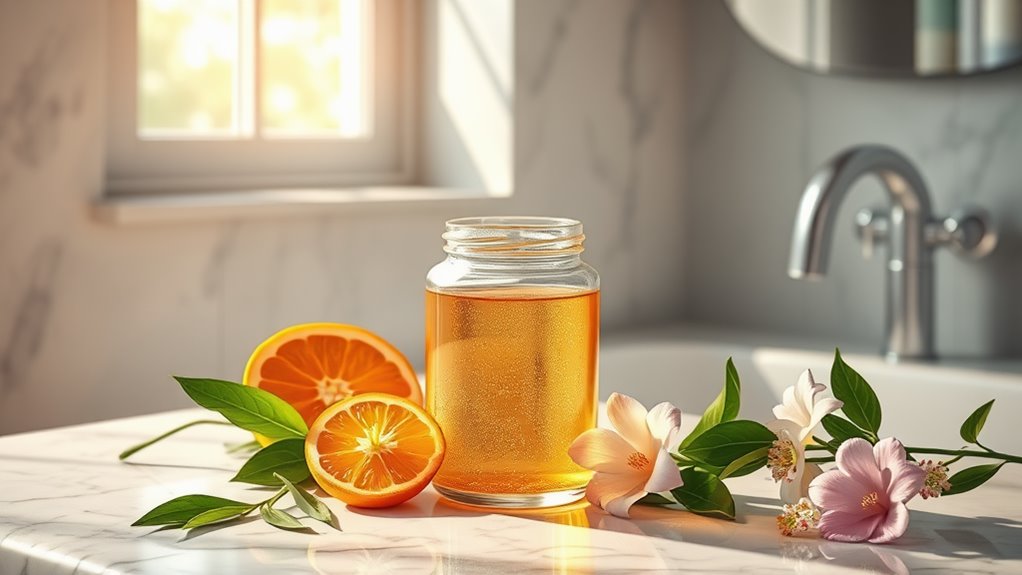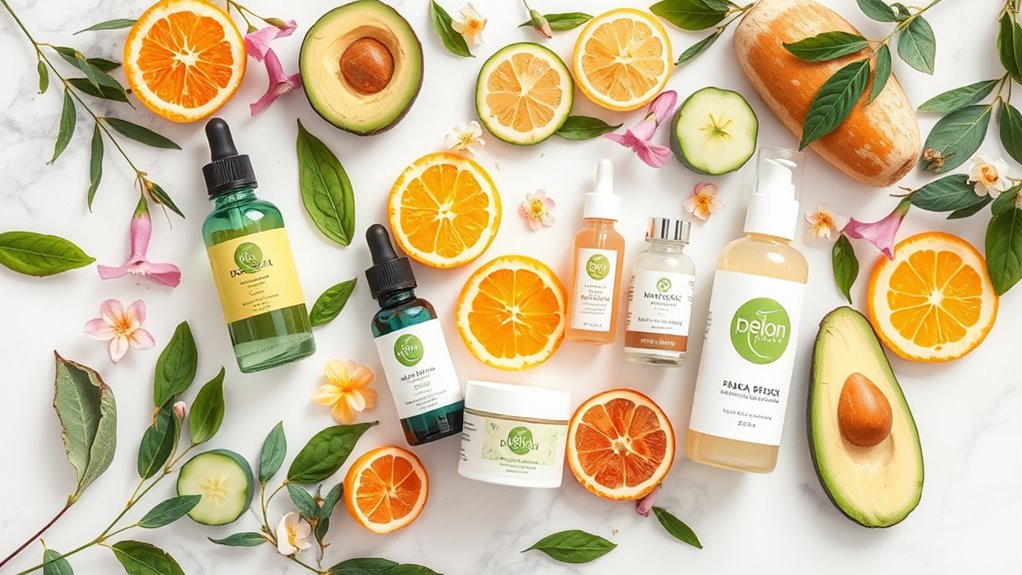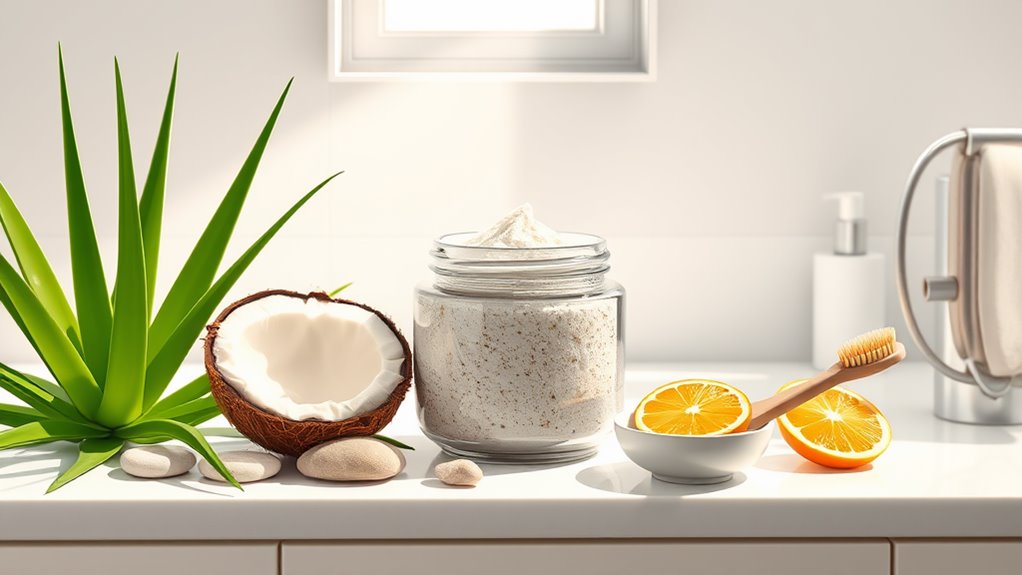How Often Should You Really Exfoliate-
Exfoliation is a vital part of any skincare routine, but figuring out how often to do it can be tricky. It all depends on your skin type and specific needs. For some, frequent exfoliation can lead to clearer skin, while for others, it might cause irritation. Understanding the right balance is essential for maintaining healthy skin. So, how do you determine what’s best for you? Let’s explore the nuances of exfoliation together.
Key Takeaways
- Exfoliate oily or acne-prone skin 2-3 times a week to clear pores and reduce breakouts.
- For dry skin, limit exfoliation to once a week to prevent irritation and maintain moisture.
- Combination skin should be exfoliated 1-2 times a week, adjusting based on skin’s reaction.
- Sensitive skin needs exfoliation every 1-2 weeks with milder products to avoid redness and irritation.
- Mature skin should use gentle exfoliants that promote collagen production without being abrasive.
Understanding Exfoliation: What It Is and Why It Matters
Exfoliation is an essential step in your skincare routine that helps keep your skin looking fresh and vibrant.
By removing dead skin cells, you promote cell turnover, allowing your skin to breathe and absorb products more effectively.
Mastering exfoliation can elevate your skincare game, and there are some effective exfoliation hacks you can incorporate.
For instance, try using a gentle scrub with natural ingredients like sugar or coffee grounds, or opt for a DIY mask with honey and oatmeal.
Remember, consistency is key—exfoliate once or twice a week, depending on your skin type.
Over-exfoliating can lead to irritation, so listen to your skin.
With the right approach, you’ll achieve a radiant complexion that turns heads.
Different Types of Exfoliants: Physical vs. Chemical
When it comes to exfoliation, you’ve got two main options: physical and chemical exfoliants.
Physical exfoliants use granules or tools to scrub away dead skin, while chemical exfoliants rely on acids or enzymes to dissolve them.
Choosing the right type for your skin can make all the difference in achieving a healthy glow.
Physical Exfoliants Explained
While both physical and chemical exfoliants serve the purpose of sloughing away dead skin cells, they do so in fundamentally different ways.
Physical exfoliants rely on manual abrasion to remove dead skin, often using granules or tools like scrub brushes. You can find them in various forms, such as scrubs, sponges, and even devices like microdermabrasion machines.
When using physical exfoliants, you’ll want to choose gentle options to avoid irritation. Aim for a balanced approach by incorporating these exfoliants into your routine once or twice a week, depending on your skin type.
Pay attention to how your skin reacts, adjusting frequency and product choice as needed to maintain a healthy, radiant complexion without over-exfoliating.
Chemical Exfoliants Overview
Chemical exfoliants offer a different approach to removing dead skin cells, utilizing acids or enzymes to dissolve the bonds that hold skin together. These exfoliants can provide a deeper and more uniform exfoliation compared to their physical counterparts. Understanding the different types of chemical exfoliants is essential for mastering your skincare routine.
| Type | Key Ingredients | Benefits |
|---|---|---|
| AHA | Glycolic, Lactic | Brightens, hydrates skin |
| BHA | Salicylic | Clears pores, reduces acne |
| Enzymatic | Papaya, Pineapple | Gentle, great for sensitive skin |
Choosing the Right Type
Choosing the right type of exfoliant can greatly impact your skin’s health and appearance, so it’s important to understand the differences between physical and chemical options.
Physical exfoliants, like scrubs or brushes, slough off dead skin cells through manual abrasion. They’re great for immediate results but can be harsh if overused.
On the other hand, chemical exfoliants, such as AHAs and BHAs, dissolve dead skin cells at a cellular level, providing a deeper, gentler exfoliation. They can enhance skin texture and tone over time.
When choosing, consider your skin type: oily skin may benefit from salicylic acid, while dry or sensitive skin may prefer lactic acid.
Experiment to find the perfect balance for your skin’s unique needs.
Identifying Your Skin Type: Tailoring Your Exfoliation Routine
Identifying your skin type is vital for creating an effective exfoliation routine that caters to your unique needs. Start by evaluating whether your skin is oily, dry, combination, or sensitive.
Oily skin often benefits from more frequent exfoliation to unclog pores, while dry skin may require gentler, less frequent treatments to avoid irritation. If you have combination skin, target specific areas, and for sensitive skin, opt for mild exfoliants to prevent redness. Incorporating natural ingredients like vitamin C can also help brighten the skin and reduce dark spots.
Pay attention to how your skin reacts to different products; this feedback is significant. Establishing a personalized routine based on your skin type not only enhances your glow but also minimizes the risk of adverse reactions, allowing you to master your skincare journey with confidence.
Recommended Exfoliation Frequency for Different Skin Types
Exfoliating your skin at the right frequency is essential for maintaining its health and radiance. Different skin types require tailored approaches to achieve peak results. Here’s a quick guide to help you refine your routine:
| Skin Type | Recommended Frequency |
|---|---|
| Oily | 2-3 times a week |
| Dry | Once a week |
| Combination | 1-2 times a week |
| Sensitive | Every 1-2 weeks |
Understanding your skin type allows you to exfoliate effectively without causing irritation. For oily skin, more frequent exfoliation helps control shine. Conversely, dry or sensitive skin benefits from less frequent treatments. Master your routine by adjusting these recommendations based on your skin’s unique needs.
The Impact of Over-Exfoliation: Signs to Watch For
While maintaining a regular exfoliation routine is important, over-exfoliation can lead to negative consequences for your skin.
If you notice redness, irritation, or sensitivity, it’s a sign you might be overdoing it. Your skin may feel tight or look dull instead of radiant. You might also experience increased breakouts or flaky patches, as over-exfoliation disrupts your skin’s natural barrier.
Pay attention to how your skin reacts after exfoliating; if it feels sore or reacts negatively, it’s time to reassess your routine.
Ideally, you want to achieve a balanced exfoliation approach that enhances your glow without compromising your skin’s integrity. Additionally, common daily habits like excessive exfoliation can accelerate skin aging, so it’s crucial to listen to your skin and adjust your methods accordingly to maintain its health and liveliness.
Seasonal Considerations: Adjusting Your Exfoliation Routine
Your skin’s needs can change with the seasons, making it important to adjust your exfoliation routine accordingly. In winter, for instance, you might find your skin becomes drier and more sensitive, so you’ll want to exfoliate less frequently. Conversely, during summer, increased oil production and sweat can warrant more regular exfoliation to keep your pores clear.
| Season | Exfoliation Frequency | Recommended Method |
|---|---|---|
| Winter | Every 2-3 weeks | Gentle chemical exfoliants |
| Spring | Every week | Mechanical or chemical |
| Summer | Every 3-5 days | Lightweight scrubs |
Expert Tips for Safe and Effective Exfoliation
When it comes to exfoliating, understanding your skin type is essential for achieving the best results.
You’ll want to follow specific frequency guidelines tailored to your skin’s needs to avoid irritation.
Let’s explore expert tips that will help you exfoliate safely and effectively.
Skin Type Considerations
Understanding your skin type is essential to determine how often you should exfoliate, as each type reacts differently to various methods.
If you have oily skin, you can likely exfoliate more frequently, perhaps 2-3 times a week, to clear excess sebum and prevent breakouts.
For dry or sensitive skin, stick to once a week, using gentle exfoliants to avoid irritation.
Combination skin often benefits from a balanced approach—exfoliate the oily areas more frequently while being cautious with the dry zones.
If you have mature skin, consider using exfoliants that promote collagen production without being too abrasive.
Tailoring your exfoliation routine to your skin type guarantees you maximize benefits while minimizing potential damage.
Exfoliation Frequency Guidelines
Exfoliating the right number of times per week can make a significant difference in your skin’s health and appearance.
To master your exfoliation routine, consider these guidelines:
-
Oily/Acne-Prone Skin: Exfoliate 2-3 times a week to keep pores clear and reduce breakouts.
-
Dry/Sensitive Skin: Limit exfoliation to once a week, using gentle methods to avoid irritation.
-
Combination Skin: Exfoliate 1-2 times a week, adjusting your frequency based on how your skin reacts.
Best Products for Exfoliation: What to Look For
Choosing the right exfoliation products can make a significant difference in your skincare routine, especially since not all products are created equal.
When you’re shopping, focus on ingredients. Look for alpha hydroxy acids (AHAs) like glycolic acid for a chemical exfoliant that brightens and smooths. If you prefer physical exfoliants, opt for gentle scrubs with fine granules to avoid irritation.
Always check for pH balance; products should ideally fall between 4.0 and 5.5 for effectiveness without compromising your skin barrier. Additionally, consider your skin type: sensitive skin benefits from milder formulations, while oily skin can handle stronger options.
Finally, don’t forget to patch-test any new product to verify compatibility with your skin before fully incorporating it into your routine.
Common Misconceptions About Exfoliation Debunked
While many people believe that more exfoliation equals better results, this isn’t always the case. Over-exfoliating can actually damage your skin, leading to irritation and sensitivity.
Here are three common misconceptions you should be aware of:
-
Exfoliating Daily is Necessary: Your skin needs time to recover. Aim for 2-3 times a week instead.
-
All Exfoliants are Created Equal: Chemical exfoliants can be gentler and more effective than physical ones. Choose wisely based on your skin type.
-
You Can’t Overdo it with Gentle Products: Even gentle exfoliants can disrupt your skin’s barrier if used excessively. Moderation is key.
Frequently Asked Questions
Can I Exfoliate if I Have Active Acne?
If you have active acne, exfoliating can irritate your skin further. Instead, focus on gentle methods like chemical exfoliants that target acne without causing additional inflammation. Always consult a dermatologist for personalized advice.
Should I Exfoliate Before or After Cleansing My Face?
You should exfoliate after cleansing your face. This way, you remove dirt and impurities first, allowing the exfoliant to penetrate better and effectively slough off dead skin cells, revealing a smoother, more radiant complexion.
Is It Safe to Exfoliate During Pregnancy?
It’s generally safe to exfoliate during pregnancy, but you should choose gentle methods. Avoid harsh scrubs or chemical peels. Always consult your healthcare provider to guarantee your skincare routine aligns with your unique circumstances.
Can I Use Multiple Exfoliants in One Routine?
Yes, you can use multiple exfoliants in one routine, but balance is key. Layer gentle products, and pay attention to your skin’s response. Adjust frequency and intensity to avoid irritation while achieving desired results.
What Should I Do if My Skin Feels Irritated After Exfoliating?
If your skin feels irritated after exfoliating, immediately stop using the product. Apply a soothing moisturizer or aloe vera to calm your skin. Consider reducing exfoliation frequency, and choose gentler options to prevent future irritation.
Conclusion
In conclusion, finding the right exfoliation routine is essential for healthy skin. By understanding your skin type and adjusting your frequency accordingly, you can achieve a radiant complexion without overdoing it. Remember to pay attention to your skin’s response and be mindful of seasonal changes. With the right products and techniques, you’ll keep your skin fresh and vibrant. So, embrace exfoliation, but always do it safely and effectively for the best results!





